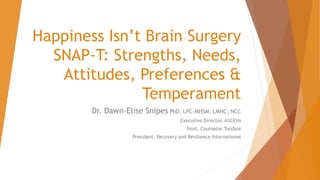
Happiness isn’t brain surgery temperament SNAP-T
- 1. Happiness Isn’t Brain Surgery SNAP-T: Strengths, Needs, Attitudes, Preferences & Temperament Dr. Dawn-Elise Snipes PhD, LPC-MHSM, LMHC, NCC Executive Director, AllCEUs Host, Counselor Toolbox President, Recovery and Resilience International
- 2. Explore the concept of SNAP-T Review the different learning styles Identify the characteristics of each dimension of temperament Discuss the levels of Maslow’s heirarchy Identify other characteristics which may yield specialized needs. Objectives
- 3. Strengths Needs (Accommodations) Attitudes Preferences (learning style, temperament) SNAP
- 4. Strengths Things the client is good at… (transferability) How the client… Learns best Has coped in the past What gives the client hope What the client already knows about The condition Recovery methods What does and does not work for him/her
- 5. Needs Emotional Happiness Contentment/Efficacy Mental/Cognitive Learning preferences Learning needs to understand the condition and interventions Physical Assistive devices Frequent breaks Medications
- 6. Needs Social Friendships Understanding of healthy relationships Environmental Safety Temperature Comfort Time of Day Transportation Child Care
- 7. How you best take in information Auditory Kinesthetic Visual How you process information Active Reflective Conceptualization Sequential Global Learning Styles Review
- 8. Attitudes Self Others The Condition/Target Issue Willingness to learn and try new things Interventions/Recovery I will not call myself an addict every day I will not go to “those meetings” Everybody relapses I have to have Suboxone to achieve recovery
- 9. Decisional Balance The Old Way The New Way/Change Benefits Reasons I want to stay the same Positive attitudes about the old way Reasons I want to change Positive attitudes about change What I hope will be different Drawbacks Things that I don’t like about the old way/staying the same. Reasons why I need to change. Concerns I have about changing Fears or negative attitudes about change
- 10. Preferences People’s temperament impacts their Strengths, Needs, Attitudes and Preferences Temperament is: Comprised of 4 dimensions Environment and Energy Mental Conceptualization Motivation and Meaning Time Management and Structure An overarching concept that is on a continuum. One end of the continuum is not better than the other, it is just different. Most people are somewhere in the middle, having characteristics of both “ends”
- 11. Improving Communication Increasing Motivation Effective Interventions Relapse Prevention Planning Application
- 12. Temperament Extrovert Introvert Are expansive and less passionate Are generally easy to get to know Like meeting new people, have many close friends Would rather figure things out while they are talking Often enjoy background noise such as TV or radio Know what is going on around them rather than inside them Often do not mind interruptions Are often considered good talkers Are intense and passionate Generally more difficult to get to know Exert effort to meet new people Have only a few close friends Figure things out before they talk Prefer peace and quiet Are more likely to know what is going on inside them than what is going on around them Dislike being interrupted Are often good listeners
- 13. Temperament Sensing iNtuitive Are practical and realistic Prefer facts and live in the real world Content in general Would rather do than think Focus on practical, concrete problems See the details and may ignore the big picture Want specifics and tend to be very literal May think that those preferring intuition are impractical Believe “if it isn’t broken, don’t fix it” Are imaginative dreamers Prefer abstraction, inspiration, insights Live in the world of possibilities Would rather think than do Focus on complicated abstract problems See the big picture but miss the details Love word games May think that those preferring the practical lack vision Believe anything can be improved Focus on the future and possibilities
- 14. Temperament Thinking Feeling Like words such as principles, justice, standards or analysis Respond most easily to people’s thoughts Want to apply objective principles Value objectivity above sentiment Can assess logical consequences Believe it is more important to be just than merciful Assess reality with a true/false lens May think that those who are sentimental take things too personally May argue both sides of an issue for mental stimulation Like words such as care, compassion, mercy, intimacy, harmony, devotion Respond most easily to people’s values Want to apply values and ethics from multiple perspectives Value sentiment above objectivity Good at assessing the human impact Believe it is more important to be caring/merciful Assess reality with a good/bad lens Think that those preferring objectivity are insensitive Prefer a to agree with those around them
- 15. Temperament Judging Perceiving Plan ahead Self disciplined and purposeful Thrive on order Get things done early. Plan ahead & work steadily. Define and work within limits Maybe hasty in making decisions Time and deadline oriented Thinks those preferring spontaneity are too unpredictable Excellent planners. May not appreciate or make use of things which are not planned or expected Adapt as they go Flexible and tolerant Thrive on spontaneity Get things done at the last minute depending on spurt of energy Want more information May fail to make decisions Always think there’s plenty of time Think that those who are not spontaneous are too rigid Good at handling unplanned events, but may not make affective choices among the possibilities.
- 16. Apply It Client with depression and a history of addiction wants to “stay in recovery” What do you need to know about his: Strengths? Needs Attitudes Preferences
- 17. Treatment involves helping people learn what is causing their distress and tools to manage it. Effective change involves helping people Maximize their strengths Consider their needs and motivations Address their attitudes Work in harmony with their own preferences As a coach or clinician, it is important to pay attention to the potential pitfalls of your treatment or discharge plan based on the person’s SNAP-T Summary
